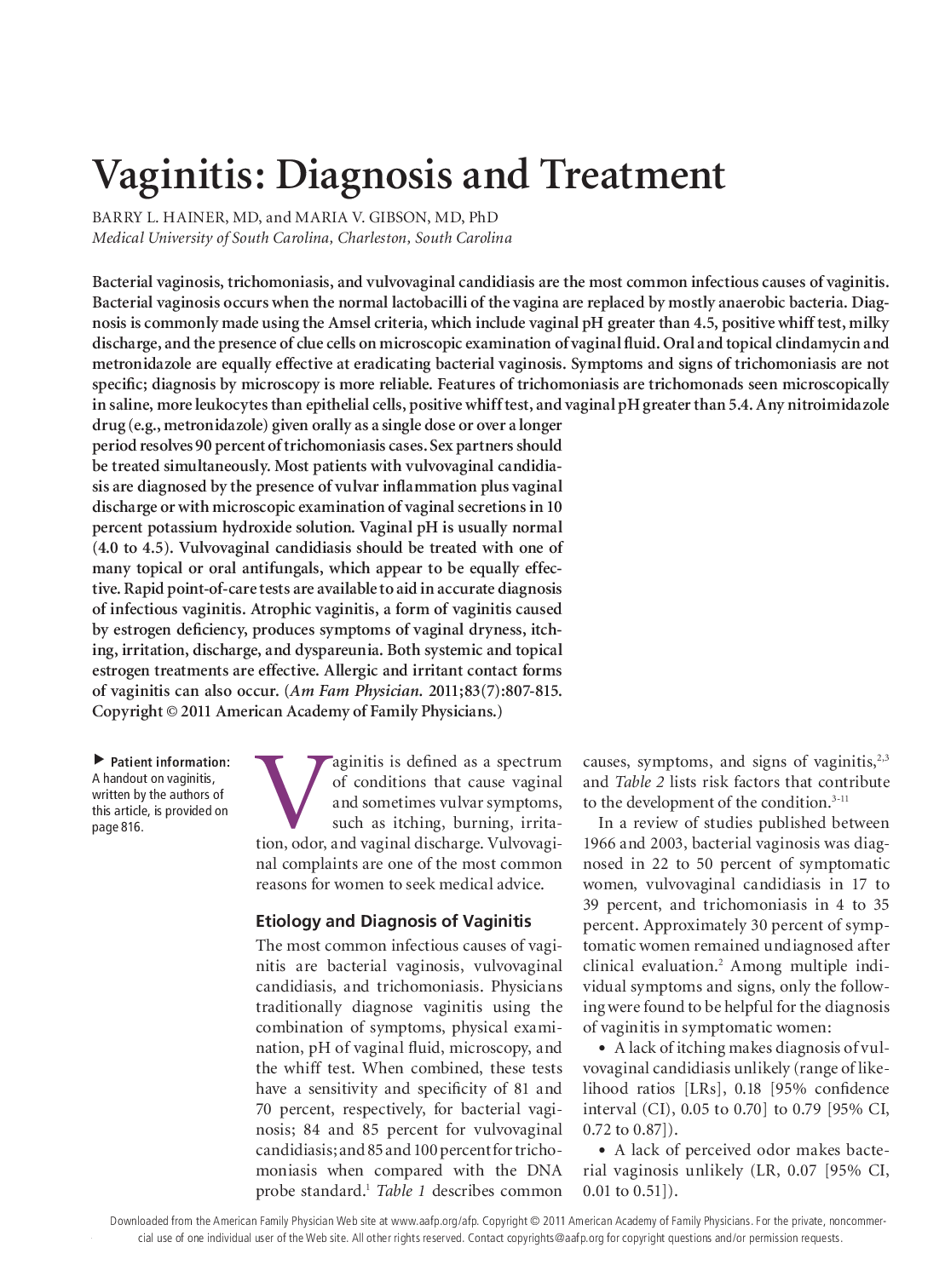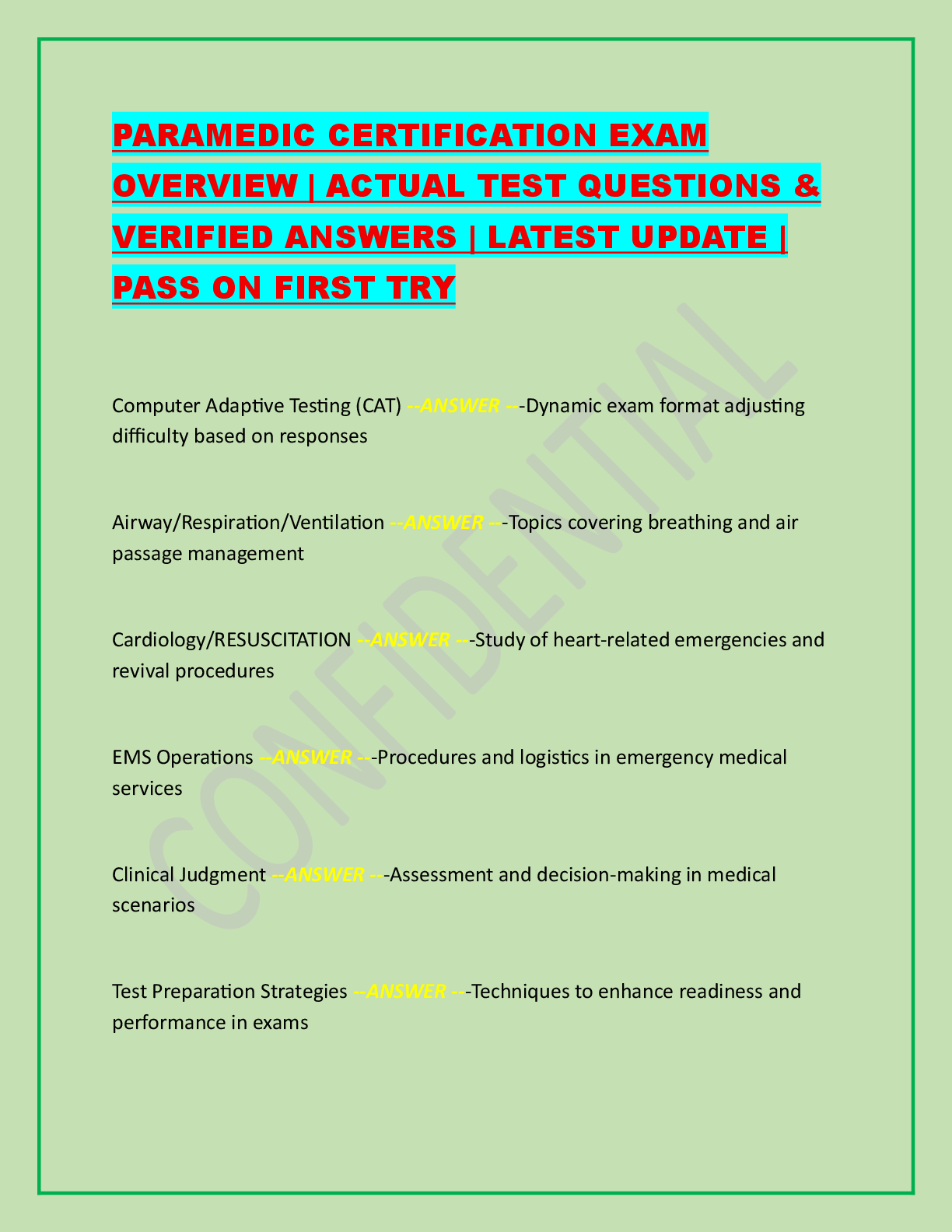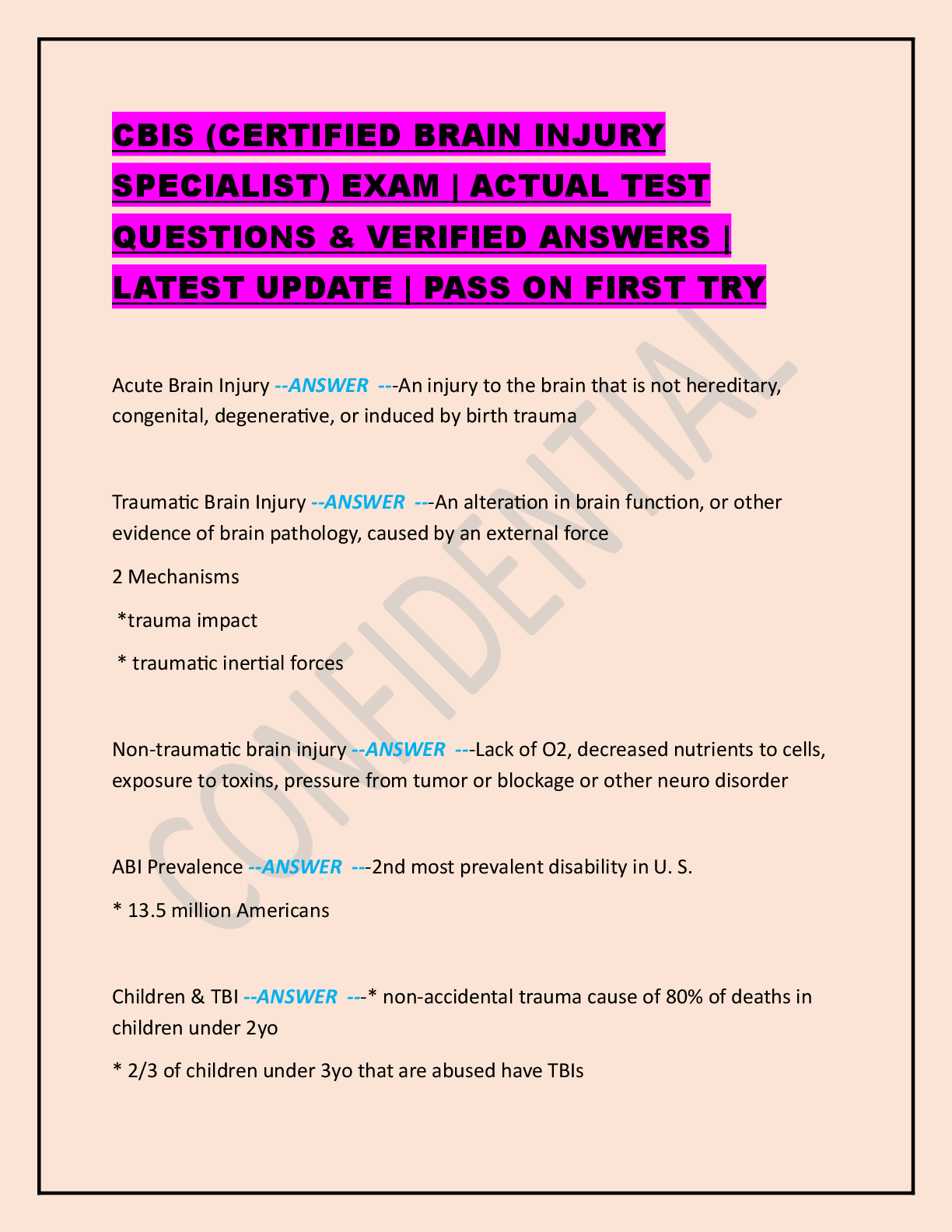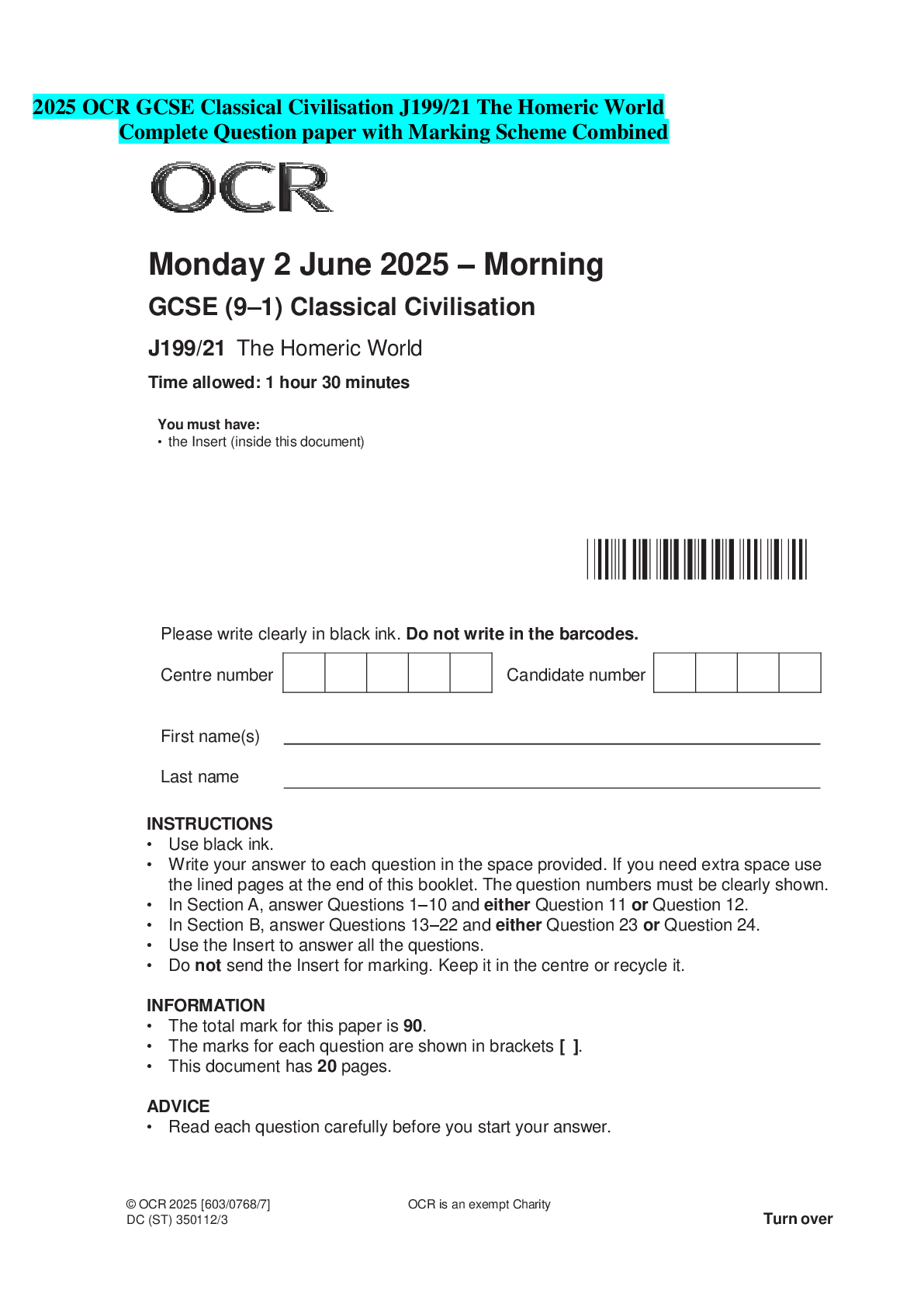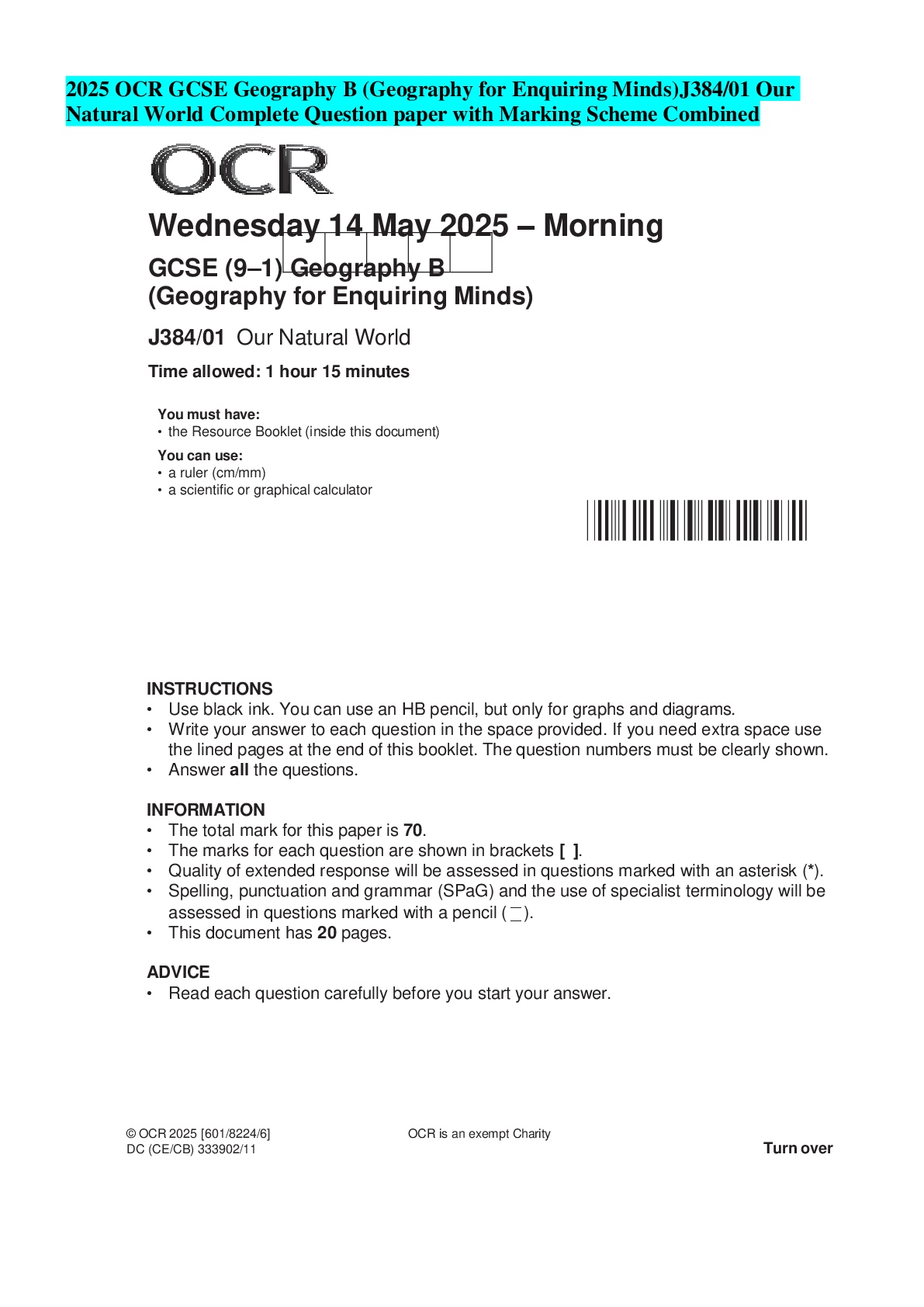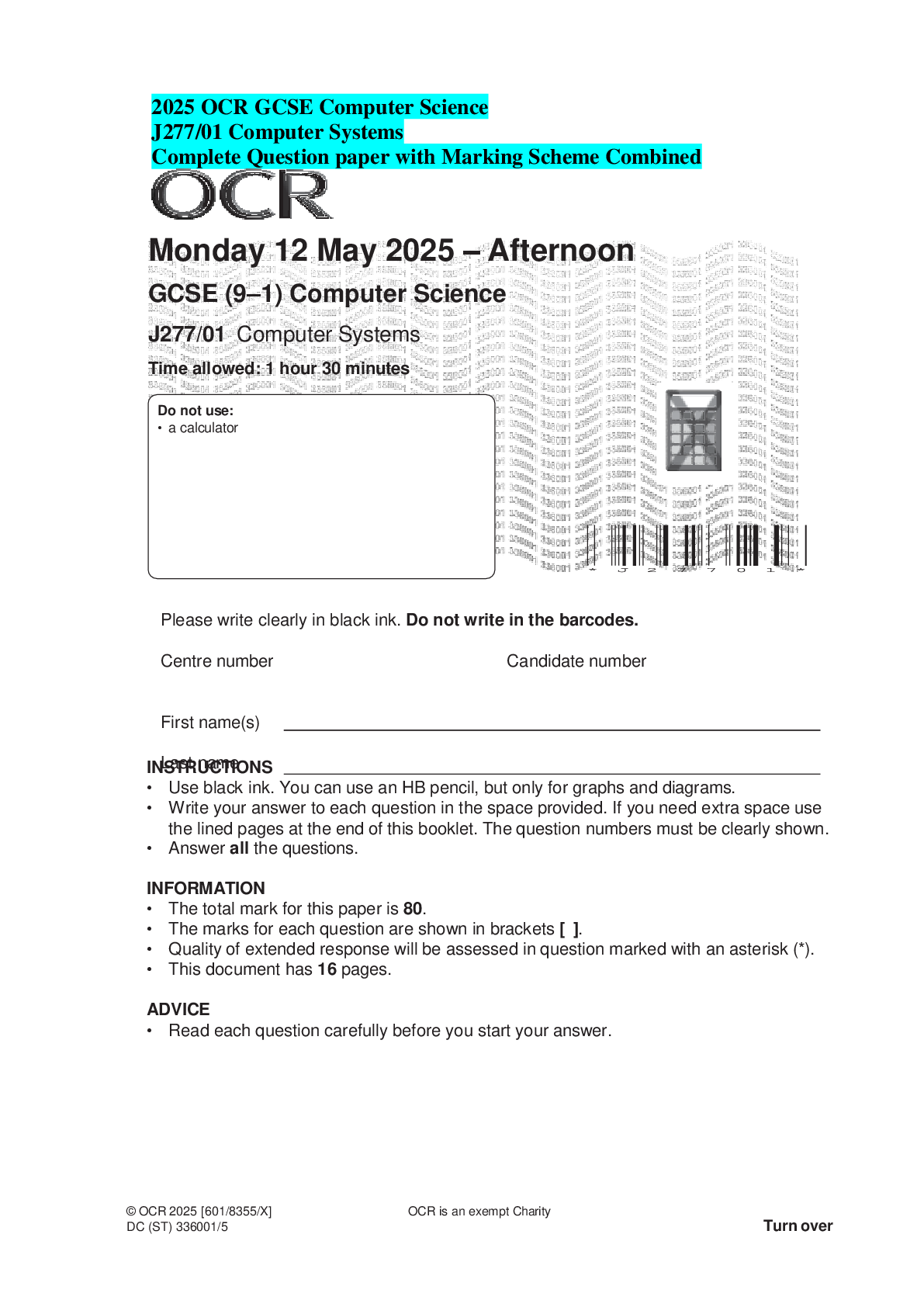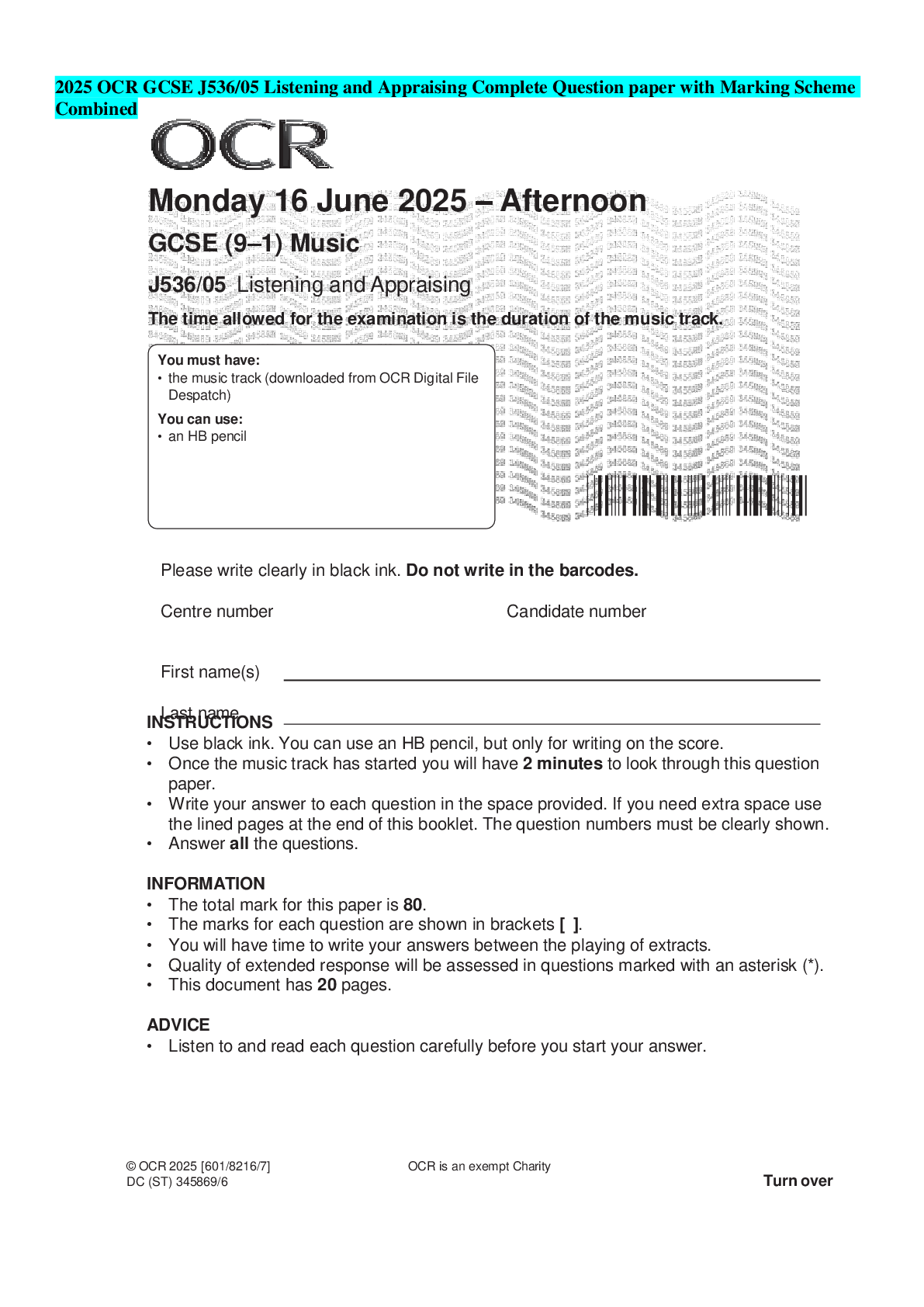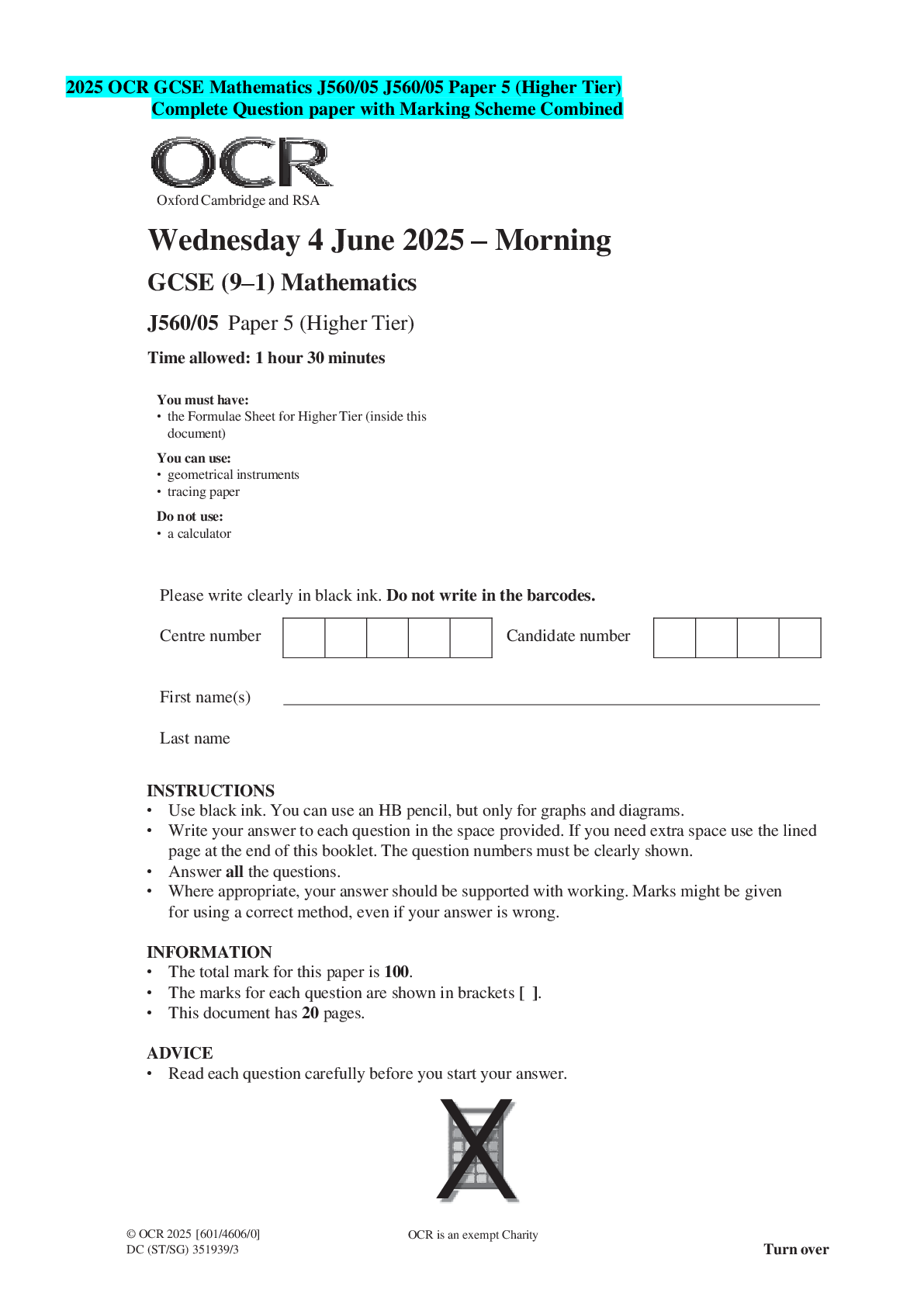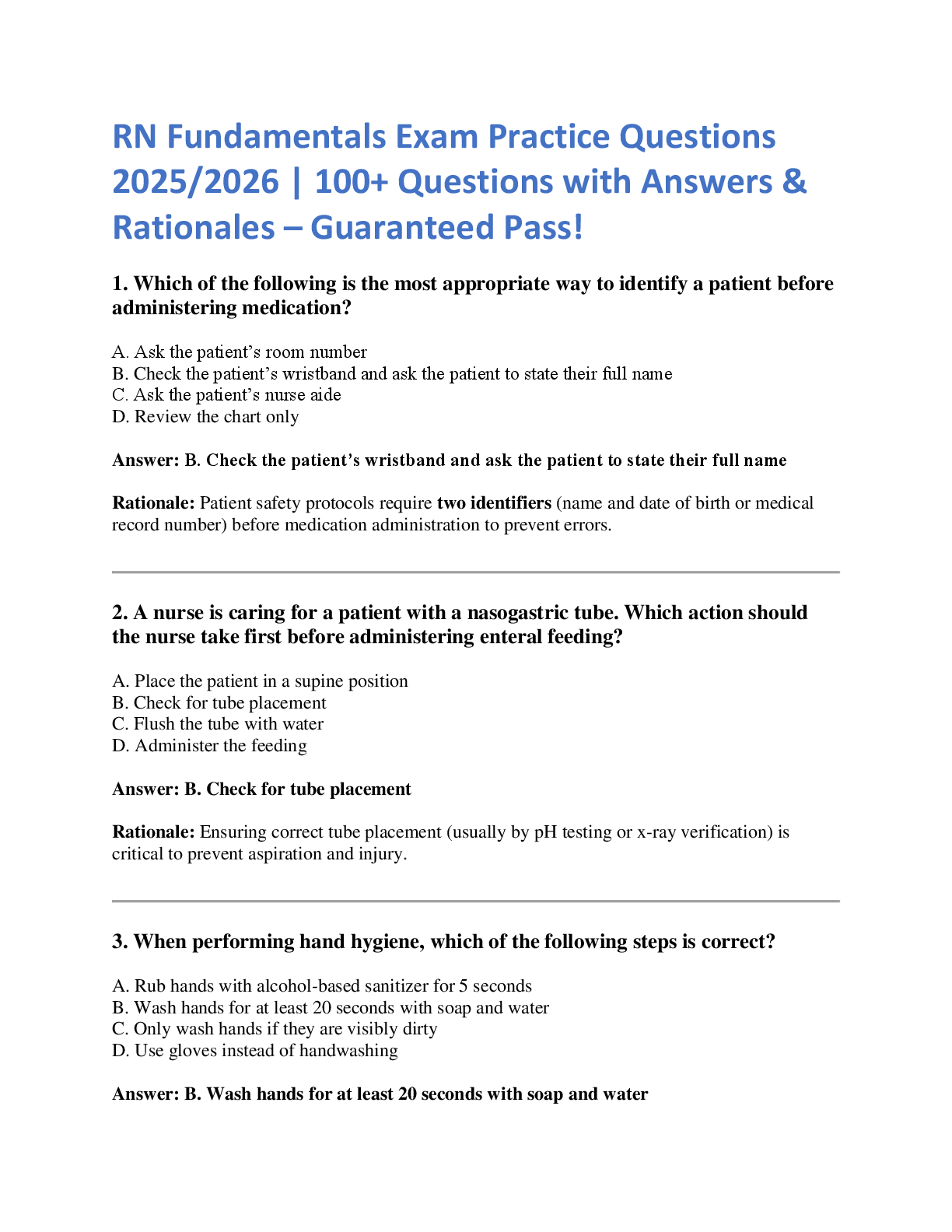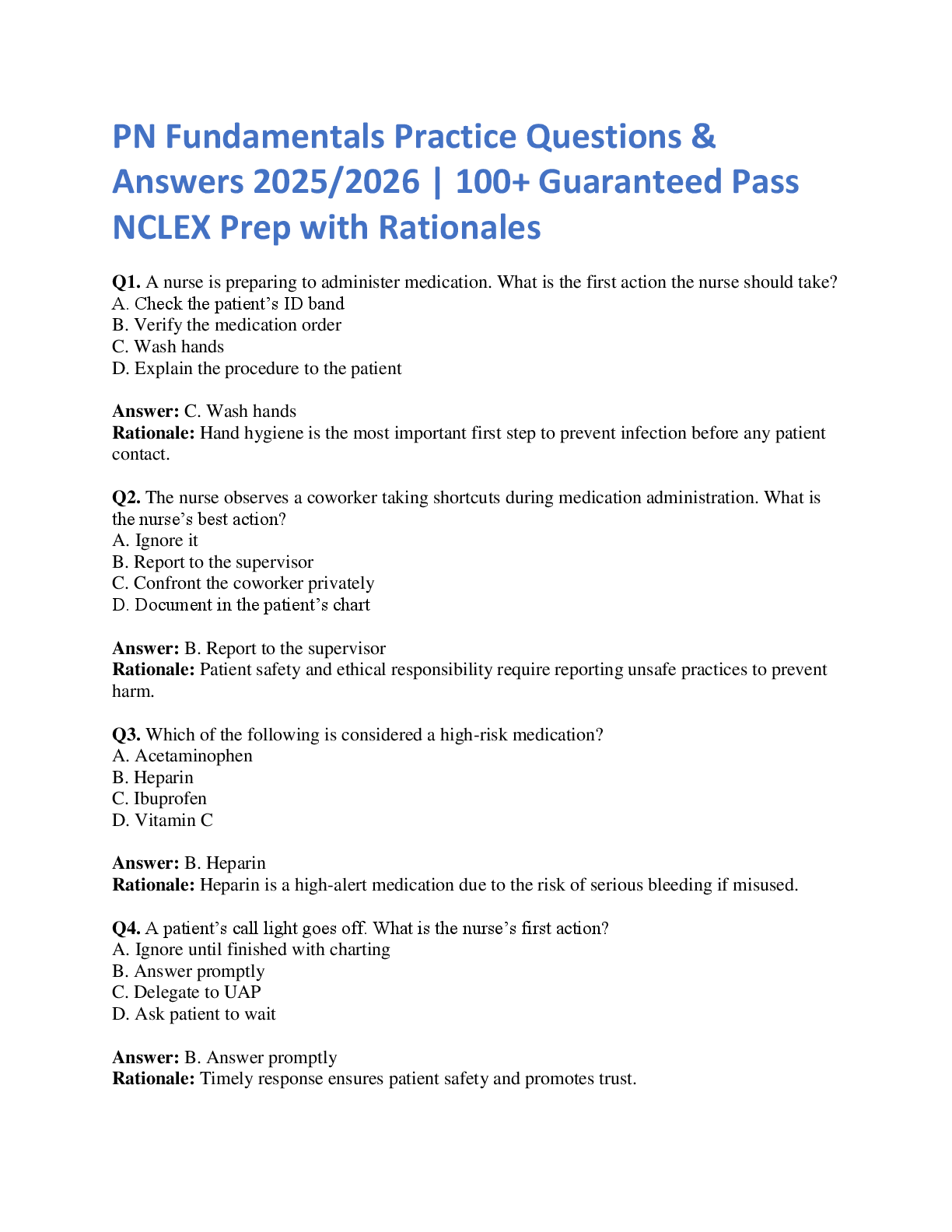*NURSING > EXAM REVIEW > NURS 225 Med Surg Exam 5 completed A (All)
NURS 225 Med Surg Exam 5 completed A
Document Content and Description Below
NURS 225 Med Surg Exam 5 Know the following all 12 Cranial Nerves (Function, Type: motor, sensory, both, How to assess) Cranial Nerves Mnemonics 1. Oh: Olfactory-smell 2. Oh: Optic- Visual (use e ... ye chart) 3. Oh: Oculomotor-Pupillary constriction and eye movement. (blink) 4. To: Trochlear-Downward and inward gaze (look down) 5. Touch: Trigeminal-Facial sensation and mastication (clinch jaw, touch face gently) 6. And: Abducens-Lateral eye movements (look to each side) 7. Feel: Facial-Taste, smiling, and frowning (smile) 8. A: Acoustic-Hearing and balance (have them stand on 1 foot with eyes closed, hearing) 9. Girls: Glossopharyngeal-Taste, gag reflex, swallowing, and throat (swallow) 10. Vagina: Vagus-Larynx, voice box, and decreased heart rate (speak, check pulse) 11. So: Spinal Acccessory-Shoulder shrugs (shrug shoulders, turn head side to side) 12. Hot: Hypoglossal-Movement of the tongue (stick out tongue) 1. Some 2. Say 3. Marry 4. Money 5. But 6. My 7. Brother 8. Says 9. Big 10. Boobs 11. Matter 12. More Bell's Palsy - Definition, Clinical Manifestations, Treatment, Affected Cranial Nerve. o Transient cranial nerve disorder affecting CN VII, characterized by a disruption of the motor disruption of the motor branches on one side of the face, which results in the. muscle weakness or flaccidity on the affected side. o Involves the seventh cranial nerve o Cause unknown, viral link is suspected o Weakness and paralysis of facial muscles o Sx develop over a few hrs – 1-2 days o Facial pain, pain behind the ear, numbness, diminished blink reflex, ptosis of the eyelid, lag or inability to close eyelid on affected side, muscle distortion, pain behind the ear, drooping of the mouth, decreased taste sensation o Diagnostic - EMGo Tx - corticosteroids, antivirals, moist heat may relieve pain Parkinson's Disease - Definition, Clinical Manifestations, Treatment. o Usually begins after 50 years of age o Primarily affects the basal ganglia and connections in the substantia nigra and corpus striatum o Parkinsonism is used to describe the cluster of Parkinson’s like symptoms that develop from several etiologies o Primary characteristic is abnormal movement o Results from a deficiency of the neurotransmitter dopamine o In the absence of dopamine, another area of the brain, known as the globus pallidus, which responds to acetylcholine, becomes overactive. The imbalance between dopamine and acetylcholine results in a movement disorder that characterizes Parkinson’s disease o In most cases no cause can be found for dopamine depletion o The symptoms are associated with exposure to environmental toxins such as insecticides and herbicides and self-administration of an illegal synthetic form of heroin known as MPTP, symptoms also can occur as sequelae of head injuries and the encephalitis. o phenothiazine o Stiffness-rigidity, tremors o Bradykinesia o Weight loss o Shuffling gait o Slurred speech o Symptoms are initially unilateral but eventually become bilateral o Eldepryl (selegiline)-increases dopamine and reduces wearing off phenomenon when given with levodopa. Avoid foods high in tyramine which can cause a hypertensive crisis. o Levodopa-converted to dopamine in the brain, increasing levels (has a wearing off phenomenon) o Cogentin (benztropine)-control tremors and rigidity. Monitor for anticholinergic effects (dry mouth) o Sinemet (levodopa-carbidopa) o Apomorphine-dopamine agonist. Monitor for orthostatic hypotension, dyskinesias, and hallucinations o Stereotaxic pallidotomy-destroys part of the globus pallidus to eliminate or reduce tremor, stooped posture, shuffling gait, and stiff movement o Deep brain stimulation-(DBS) involves the implantation of neurostimulator that works like a pacemaker for the brain o Gene therapy Stages: 1. Unilateral shaking or tremor of one limb 2. Bilateral limb involvement occurs, making walking and balance difficult 3. Physical movements slow down significantly, affecting walking more 4. Tremors can decrease but akinesia and rigidity make day-to-day tasks difficult 5. Client unable to stand or walk, is dependent for all care, and might exhibit dementia ICP - Definition, Clinical Manifestations, Treatment. o Normal ICP remains at 15mmHg or below to ensure normal cerebral perfusion pressure (CPP) of 70 to 100mmHg. Many conditions including brain tumors, swelling or bleeding within the brain from head trauma and infectious and inflammatory disorders of the brain. o When the intracranial volume begins to increase, some initial compensation occurs. o If increased ICP continues to be unrecognized or untreated, the contents of the cranium are compressed further. o Unrelieved pressure causes brain tissue to herniate or shift from normal locations intracranial and extracranial o Foramen magnum provides the only extracranial exit of brain tissue. If the brainstem herniates through the foramen magnum, respiration, heart rate, BP, and functions of the descending and ascending nerve fibers are affected o Monroe Kellie hypothesis: because of the limited space for expansion w/i the skull, an ↑ in any one the components causes a change in the volume of others Signs and symptoms of ICP o S/S - flat affect, restlessness, pupillary edema, headache, vomiting, changes in speech, Cushing’s triad (increased systolic pressure, widening pulse pressure, decreased pulse rate, and Cheyne Stokes respirations), seizures, abnormal posturing, decreased motor function. Early: o Unresponsive o GCS less or = to 12 o Decreased response to painful stimuli o Decorticate or decerebrate posturing o Increased weakness or hemiparesis o Dilated pupil(s) o Seizures o Cushing’s triad o Loss of gag and corneal reflex o Periods of apnea Late: o Drowsiness o Restlessness o Confusion o Irritability o GCS greater or = to 13 o Personality changeso Sluggish or unequal pupil response o Weakness in arms or legs o Slowed or slurred speech o Dull headache o Vomiting without nausea o Cushing’s triad- Cheyne-stokes respirations. The pulse increases initially but then decreases, systolic Bp rises which causes a widening pulse pressure, resp rate is irregular. o Goal is to decrease ICP by relieving the cause if possible o Maintain BP o Prevent hypoxia o Ensure cerebral perfusion o Supplemental Oxygen o Tylenol o Valium o Versed o ICP monitoring device o Osmotic diuretics o Pepcid o Foley, NG, tube feedings o Isotonic NS or LR, or hypertonic 3% saline solutions. o Normal ICP in the ventricles is 1 to 15mm hg, desires below 20. o Mannitol with fluid restriction. Easily crosses the blood brain barrier. Pulls electrolytes from blood and excretes it out. Can cause fluid volume overload. Be careful giving to CHF patients o Pepcid prevent stress ulcers o Emergency surgery. o Nursing management o Keep head of the bed elevated head midline (35-45%) o Administered meds as ordered o Monitor blood glucose levels o Keep wounds clean and dry o Prevent flexion of the neck and hips o Monitor respiratory status and prevent hypoxia o Maintain body temperature o Prevent shivering, which can raise ICP o Decrease environmental stimuli o Monitor electrolyte levels and acid base balance o Monitor I&O o Limit fluid intake to 1200ml per day o Instruct the client to avoid straining activities o Avoid Valsalva maneuver o Surgical Intervention o Ventriculoperitoneal shunt o Position client supine and turn from back to unoperated side o Monitor for signs of ICP resulting from shunt failure o Monitor for signs of infection Multiple Sclerosis - Definition, Clinical Manifestations, Treatment. o chronic progressive unpredictable disease of peripheral nerves o Onset young adult to early middle age-age 18-50 o More common in northern climates than warm climates o Autoimmune disorder with genetic and environmental triggers o Demyelinating disease: permanent degeneration and destruction of myelin sheath – Sclerosis refers to scarring – Myelin sheath is outer insulation that prevents misfiring or shorting out of nerve impulses – Caused by destruction of only CNS myelin o Initial sx vague and often dismissed as fatigue or stressed related o Most have relapsing-remitting MS with relapse followed by periods of remittance o With each exacerbation sx are more severe and last longer o As more lesions develop, a slow progressive loss of neuro function occurs o Infections and emotional upsets cause exacerbations o SX – Fatigue – Blurred vision – Diplopia – Nystagmus – Weakness – Clumsiness – Numbness of extremities – Progressive-ataxia, paralysis, incontinence, blindness and memory loss o Most definitive dx is separated oligoclonal bands with electrophoresis of CSF o No cure o Goal is to keep functional as long as possible o Disease modifying drugs-interferon beta 1, glatiramer acetate, or prednisone during exacerbations o Drugs to treat sx o Teach to avoid heat o Characterized by severe weakness of skeletal muscle groups o Autoimmune disorder- role of thymus gland and acetylcholine receptors of skeletal muscles o Sx develop because of defect in nerve transmission causing extreme muscle weakness o Hallmark-muscle weakness varies. Any voluntary muscle of the face most common. Weakness occurs with exertion or repetitive use and improves with rest o Sx include drooping of eyelids o Difficulty chewing and swallowing, double vision, voice weakness of extremities o Myasthenic crisis: increased muscle weakness, respiratory distress o Dx Iv tensilon relieves muscle weakness in seconds but lasts only 5 minutes. 1-2 year delay if mild, EMG o TX o Anticholinesterase such as Mestinon or Mytelase to prolong the acetylcholine action to sustain muscle contraction – Surgical removal of thymus gland – Prednisone – Immunosuppressants– Plasmapheresis – If disease worsening or undermedicated= myasthenic crisis then mechanical ventilation – Prognosis of nearly normal lives o Provide rest o Assess oral motor strength before and during each meal o Teach to avoid alcohol and have any otc meds drugs o Monitor drug therapy – Exact intervals to maintain therapeutic levels – Time important activities such as eating with med peaks – Signs of drug overdose (cholinergic crisis); abdominal cramps, clenched jaws and muscle rigidity – Do not give a sedative or enema Seizure Disorder - Types, Definition, Clinical Manifestations, Treatment. o A seizure is a brief episode of abnormal electrical activity in the brain. o Convulsion-one manifestation of a seizure, is characterized by spasmodic contractions of muscles o Epilepsy is a chronic recurrent pattern of seizures Classifications: Class 1 o Type 1 Generalized - no warning or aura - patient loses consciousness for a few seconds to several minutes. Both sides of the brain involved – Type 2 Tonic phase - loss of consciousness with stiffening and rigidity of muscles (30 sec-several minutes) – Type 3. Clonic phase - hyperventilation, with rapid jerking movements, muscles contract then relax. Tongue biting, incontinence, and heavy salivation may occur during this period. Lasts several minutes – Type 4. Myclonic-brief jerking or stiffening of extremities. Lasts only seconds – Type 5. Atonic or Akinetic-few seconds with loss of muscle tone, confusion Class 2: o Type 1. Complex Partial - may lose consciousness for 1-3 minutes with amnesia before or after the event, patient may be unaware of environment and perform automatic behaviors such as lip smacking o Type 2. Simple partial - usually last less than 1 minute - may have an aura prior to the seizure. Consciousness maintained, unusual sensation, déjà vu, abnormal flushing Class 3: Unclassified (Idiopathic). Do not fit into any category. Accounts for 50% of seizures o Absence (aka petit mal) - short period of time when the client is in unaltered level of consciousness. Staring, blinking is characteristic.Risk factors: genetics, acute fever, head trauma (up to 9 mo before seizures start), cerebral edema (can be caused by 3% NaCl), abruptly stopping meds, infection, metabolic D/O, exposure to toxins, stroke, heart disease (A-Fib), brain tumor, hypoxia, DTs, fluid/electrolyte imbalance. Assessment findings – Motor, sensory, and neurologic functions are normal except at the time of a seizure. – Neuro exam – EEG records electrical activity in the brain – CT scan – MRI – Serology: alcohol, drugs, HIV, toxins, CMP, CBC, ammonia level – Serum electrolyte levels Medical management – Anticonvulsant drugs – Dilantin – Tegretol – Zarontin – Depakene – Cerebyx – Valium Nursing management – Pad side rails, mats on floor – Hx – Suction, oral airway, oxygen at bedside – Drug therapy – Protect Head – Loosen clothing – Don’t restrain and put nothing in their mouth – Document everything – After seizure: keep on their side, ask about aura, determine trigger Therapeutic Procedures: – Vagal Nerve stimulator-device implanted into left chest wall on the vagus nerve. Stimulates the brain either automatically or when the pt places a magnet over it to abort seizure activity. Avoid MRIs, Ultra sounds, microwaves, and short wave radios – Conventional surgery to remove the part of the brain that is causing the seizure Status Epilepticus: Repeated seizure activity lasting 30 minutes or more. This is an emergency. Usually caused by drug withdrawal cerebral edema, injury. Worry about hypoxia, provide O2, maintain airway, give Ativan, and monitor ABG results Myasthenia Gravis - Definition, Clinical Manifestations, Treatment.Myasthenia gravis is a chronic autoimmune, neuromuscular disease that causes weakness in the skeletal muscles that worsens after periods of activity and improves after periods of rest. These muscles are responsible for functions involving breathing and moving parts of the body, including the arms and legs. The initial manifestation of myasthenia gravis in 80% of patients involves the ocular muscles. Diplopia and ptosis (drooping of the eyelids) are common. Many patients also experience weakness of the muscles of the face and throat (bulbar symptoms) and generalized weakness. Weakness of the facial muscles results in a bland facial expression. Laryngeal involvement produces dysphonia (voice impairment) and dysphagia, which increases the risk of choking and aspiration. Generalized weakness affects all extremities and the intercostal muscles, resulting in decreasing vital capacity and respiratory failure Management of myasthenia gravis is directed at improving function and reducing and removing circulating antibodies. Therapeutic modalities include administration of anticholinesterase medications and immunosuppressive therapy, intravenous immune globulin (IVIG), therapeutic plasma exchange (TPE), and thymectomy. There is no cure for myasthenia gravis; treatments do not stop the production of the acetylcholine receptor antibodies. Pyridostigmine bromide (Mestinon), an anticholinesterase medication, is the first line of therapy. It provides symptomatic relief by inhibiting the breakdown of acetylcholine and increasing the relative concentration of available acetylcholine at the neuromuscular junction. The dosage is gradually increased to a daily maximum and is given in divided doses (usually four times a day). If pyridostigmine bromide does not improve muscle strength and control fatigue, the next agents used are the immunomodulating drugs. The goal of immunosuppressive therapy is to reduce production of the antibody. Corticosteroids suppress the patient’s immune response, decreasing the amount of antibody production, and this correlates with clinical improvement. An initial dose of prednisone is given daily and maintained for 1 to 2 months; as symptoms improve, the medication is tapered (Bader et al., 2016). As the corticosteroid medications take effect, the dosage of anticholinesterase medication can usually be lowered. Cytotoxic medications are used to treat myasthenia gravis if there is inadequate response to steroids. Azathioprine (Imuran) inhibits T lymphocytes and B-cell proliferation and reduces acetylcholine receptor antibody levels. Therapeutic effects may not be evident for 3 to 12 months. Leukopenia and hepatotoxicity are serious adverse effects, so monthly evaluation of liver enzymes and white blood cell count is necessary. Thymectomy (surgical removal of the thymus gland) can produce antigen-specific immunosuppression and result in clinical improvement. Improvements may take several months to several years after surgery to occur. The entire thymus gland must be removed for optimal clinical outcomes. There are three surgical approaches: transsternal, transcervical thymectomy, and video-assisted thoracoscopic surgery. After surgery, the patient is monitored in an intensive care unit, with special attention to respiratory function. Cerebral Palsy - Definition, Clinical Manifestations, Treatment, Nursing Interventions.A condition marked by impaired muscle coordination (spastic paralysis) and/or other disabilities, typically caused by damage to the brain before or at birth. Can be treated, but not cured. Symptoms include exaggerated reflexes, floppy or rigid limbs, and involuntary motions. These appear by early childhood. Muscular: difficulty walking, difficulty with bodily movements, muscle rigidity, permanent shortening of muscle, problems with coordination, stiff muscles, overactive reflexes, involuntary movements, muscle weakness, muscle spasms, or paralysis of one side of the body Developmental: failure to thrive, learning disability, slow growth, or speech delay in a child Speech: speech disorder or stuttering Also common: constipation, difficulty swallowing, drooling, hearing loss, leaking of urine, paralysis, physical deformity, scissor gait, seizures, spastic gait, teeth grinding, tremor, or difficulty raising the foot Treatment: Spastic – Physical therapy can reduce the muscle tension and jerky movements associated with spastic cerebral palsy. Exercises such as stretching can even relieve stiffness over time. Athetoid – People with athetoid cerebral palsy use physical therapy to increase muscle tone and gain more control over their movements. Medications: Muscle relaxants like Baclofen or Tizanidine to treat muscle spasms. Sedative: Diazepam (addicting) to treat anxiety, muscle spasms. Therapy: PT, OT, speech, and neurology Glasgow Coma Scale is used to assess patients in a coma. The initial score correlates with the severity of brain injury and prognosis. The Glasgow Coma Scale provides a score in the range 3-15; Mild head injuries are generally defined as those associated with a GCS score of 13-15, and moderate head injuries are those associated with a GCS score of 9-12. A GCS score of 8 or less defines a severe head injury. Mini-Mental Status Exam The Mini-Mental Status Examination offers a quick and simple way to quantify cognitive function and screen for cognitive loss. It tests the individual's orientation, attention, calculation, recall, language and motor skills. Each section of the test involves a related series of questions or commands. The individual receives one point for each correct answer. To give the examination, seat the individual in a quiet, well-lit room. Ask him/her to listen carefully and to answer each question as accurately as he/she can. Don't time the test but score it right away. To score, add the number of correct responses. The individual can receive a maximum score of 30 points. A score below 20 usually indicates cognitive impairment.Spinal Cord Injuries - What is affected with each type (Cervical vs. Thoracic) such as blood pressure, paralysis, etc. The higher the lesion, the more severe the sequelae Patients with lesion at C4 or higher may require ventilatory support Lesions between T1 - T 8 often allow use of the hands Lesions below T8 often allow upper body control Bladder dysfunction will occur as a result of the injury - normal bladder control is dependent on the sensory and motor pathways and the lower motor neurons being intact. C4 injury - tetraplegia, results in complete paralysis below the neck C6 injury - results in partial paralysis of hands and arms as well as the lower body T6 injury - paraplegia, results in paralysis below the chest L1 injury - paraplegia, results in paralysis below the waist Neurogenic shock is a complication of spinal trauma, causing a sudden loss of communication within the sympathetic nervous system that maintains the normal muscle tone in blood vessel walls. This can occur within 24 hours of injury, resulting in a drop in cardiac output and heart rate, and a life-threatening decrease in blood pressure. This can last for several days to weeks.– Monitor for hypotension, dependent edema, and loss of temperature regulation – When in an upright position, client swill experience postural hypotension. Transferring to a wheelchair should occur in stages: • Raise the head of the bed, lower it back if dizziness occurs • Transfer to a reclining wheelchair with the back reclined • If the client reports dizziness, recline the chair further. • Monitor for thrombophlebitis (swelling of extremity, absent/decreased pulses, and areas of warmth and/or tenderness Expressive Aphasia - Define, What population, Communication Methods Able to understand what is said but is unable to communicate verbally. Occurs after a stroke or with a brain tumor. – Assess the ability to understand speech by asking the client to follow simple commands – Observe for consistently affirmative answers when the client actually does not comprehend what is being said – Assess accuracy of yes/no answers in relation to closed-ended questions – Supply the client with a picture board of commonly requested items/needs – For expressive and receptive aphasia speak slowly and clearly, use one-step commands Informed consent vs implied consent The nurse may ask the patient to sign the consent form and witness the signature; however, it is the surgeon’s responsibility to provide a clear and simple explanation of what the surgery will entail prior to the patient giving consent. The surgeon must also inform the patient of the benefits, alternatives, possible risks, complications, disfigurement, disability, and removal of body parts as well as what to expect in the early and late postoperative periods. The nurse clarifies the information provided, and if the patient requests additional information, the nurse notifies the physician. The nurse ascertains that the consent form has been signed before administering psychoactive premedication, because consent is not valid if it is obtained while the patient is under the influence of medications that can affect judgment and decision-making capacity. Implied consent law: The law assumes that an unconscious patient would consent to emergency care if the patient were conscious and able to consent. ... The health care providers may rely upon implied consent only in the absence of consent. Implied consent can never overrule the explicit rejection of medical care. Lumbar Puncture - Procedure, Patient Education, Nursing Interventions – Prior to the procedure, discuss the risks vs benefits with the patient. Can be associated with rare but serious complications such as brain herniation, esp with increased ICP – If taking anticoagulants, can result in bleeding that compresses the spinal cord.Nursing Action: – Ensure that the client removes all jewelry and is only wearing a hospital gown – Have them void before starting – Clients should be positioned to stretch the spinal canal. This can be done by having the client assure a fetal or “cannon ball” position while on the side or by having them stretch over an overbed table if sitting is preferred. Intra-procedure: – The area of the needle insertion is cleansed, and a local anesthesia is applied – The needle is inserted, and the CSF is withdrawn, after which the needle is removed – A monometer can be used to determine the opening pressure of the spinal cord, which is useful if increased pressure is a consideration Post-procedure: – CFS is sent to the pathology department for analysis, cover area with dressing – Monitor the puncture site. The client should remain lying for several hours(4-6) to ensure that the site clots and to decrease the risk of a postlumbar puncture headache, caused by CSF leakage (symptoms: HA, N/V, photophobia, imbalance, tinnitus). – VS, neuros Q4 hours for 24 hours, monitor I&O – Increase fluids to 3L in 24 hours – Normal results: pressure of 70-80, colorless fluid, glucose of 50-80, no organisms Complications: Brain stem herniation-sudden shifting of brain causing herniation of lower brain stem (life threatening) Right (vs) Left Hemisphere CVA - Know Signs and Symptoms for each. Right: o Left sided paralysis or weakness o Left visual field deficit o Spatial-perceptual deficits o Increased distractibility o Impulsive behavior and poor judgement o Lack of awareness of deficits on the affected side o Misjudges distances o Difficulty distinguishing upside-down and right side-up o Impairment of short-term memory o Neglect of the left side of the body, objects and people on the left sideLeft: o Right sided paralysis or weakness o Right visual field deficit o Aphasia (global, expressive, or receptive) o Altered intellectual ability o Slow, cautious behavior o Short retention of information o Requires frequent reminding to complete tasks o Difficulty in new learning o Problems with abstract thinking Ischemic strokes • Occur when a thrombus or embolus obstructs an artery carrying blood to the brain • Glucose and oxygen to brain cells are reduced • Adenosine triphosphate is depleted • Accumulation of lactic acid • Release of glutamate • Glumate activates neuronal receptors called (NMDA) The receptors allow large amounts of calcium followed by glutamate into the cell. Once the glutamates is inside the brain cells, it overexcites them, causing disordered enzyme activities that release toxic free radicals, which cause cell destruction. Hemorrhagic strokes • Blood leaks from intracerebral arteries • The collection of blood adds volume to the intracranial contents, resulting in elevated pressure • Most common in the cerebellum and brain stem. Phenytoin - (Drug Classification & Side Effects). Class: Hydantoins, anticonvulsant, antiarrhythmics (group IB) Side Effects: Causes oral gum overgrowth, decreases the effectiveness of oral contraceptives, and should not be given with warfarin as phenytoin can decrease absorption and increase metabolism of oral anticoagulants, making the level higher (ATI) Drug Book major side effects: Ataxia, diplopia, nystagmus, hypotension, N/V, hypertrichosis, rash, Stevens Johnson Syndrome Calculate (Gtt/min): Volume/time (min) x drop factor Rounding IV and PO medications Things he said to review in lecture:Headaches: Review cluster and migraine HAs in ATI page 59 and 60. Macular Degeneration: ATI page 63 Glaucoma: ATI page 65 [Show More]
Last updated: 3 years ago
Preview 1 out of 15 pages
.png)
Buy this document to get the full access instantly
Instant Download Access after purchase
Buy NowInstant download
We Accept:

Reviews( 0 )
$7.50
Can't find what you want? Try our AI powered Search
Document information
Connected school, study & course
About the document
Uploaded On
May 16, 2021
Number of pages
15
Written in
All
Additional information
This document has been written for:
Uploaded
May 16, 2021
Downloads
0
Views
115






